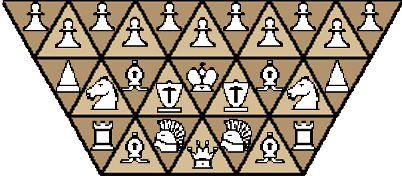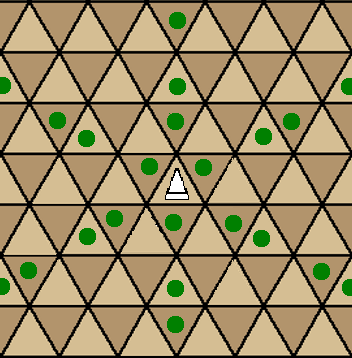Battle of the Six Armies
I have a fascination for unusual boards – that is boards that do not use squares to indicate piece positions. There are three regular two-dimendional shapes that tile the plane, namely the square, the hexagon, and the triangle. Far and away the rarest shape used for board games is the triangle. Also comparatively rare are chess variants that cater for more than 2 players. This variant attempts a combination of both rarities.Setup
This is shown in the next two images below. Â Â
 Â

The six armies are White, Blue, Gold, Black, Green, Red.
Each army contains 27 pieces: 11 Pawns, 2 Guards, 2 Champions, 2 Knights, 4 Bishops, 2 Spires, 2 Towers, 1 Queen and 1 King; and occupies a trapezium shaped area bordering a central hexagonal area. This central area contains 216 triangular cells (trigs), giving a total of 378 trigs for the complete board.
Pieces
The legal moves for each piece are illustrated in the images that follow. It should be noted that:- the King
- cannot castle
- may move into or be left in check
- the Queen may move as either Spire or Bishop
- the Tower, Spire and Bishop may not leap.
- the Bishop is colour-bound.
- the Knight is a 2-trig leaper.
- the Champion is part 2-trig leaper and part 1-trig stepper.
- the Pawn
- on its first move may make 1 or 2 passive steps directly
forwards or capture obliquely forwards 1 trig
(see the left most pawn, passive steps in green, capturing steps in red.) - on subsequent moves the pawn may move passively 1 trig directly
fowards or sideways. Capturing steps are as before.
(see the centre and right-most pawns; passive blue , white; capture yellow, black.) - There is no en-passant capture.
- pawns may promote when moving into a trig that is beyond the
half-way line (10th rank or higher)
- for white that is the black side of the white line
- for blue that is the green-side of the green line
- and so on ...
- promotion is always optional
- promotion is to a piece previously removed from play (captured).
King |
Queen |
Tower |
Spire |
Bishop |
Guard |
Knight |
Champion |
Pawn Â Â Â Â  |
|
Rules
The pieces and their moves are given above. Other rules generally are as for FIDE chess except that the aim is to capture all enemy Kings: there is no check or checkmate. Any army that has its King captured is removed from the board.ÂOrder of play
- fixed round - white, blue, gold, black, green, red.
- random - at start of each round throw dice for first to move in a round and direction
- 1 = white, 2 = blue, 3 = gold; 4 = black, 5 = green, 6 = red
- 1,2,3 = move passes clockwise; 4,5,6 = move passes anti-clockwise.
Suggested modes of play
- six players
- play as individuals
- play as 2 teams of three: (white, gold, green) against (black, red, blue)
- play as 3 teams of two (white, black), (gold, red), and (green, blue)
- five players
- remove one army from play
- designate one army as neutral and use random order of play. First mover in a round will also make the move for the neutral army in that round.
- four players
- remove two armies from play
- three players
- each player controls 2 armies
- two players
- each player controls 3 armies.
 This 'user submitted' page is a collaboration between the posting user and the Chess Variant Pages. Registered contributors to the Chess Variant Pages have the ability to post their own works, subject to review and editing by the Chess Variant Pages Editorial Staff.
This 'user submitted' page is a collaboration between the posting user and the Chess Variant Pages. Registered contributors to the Chess Variant Pages have the ability to post their own works, subject to review and editing by the Chess Variant Pages Editorial Staff.
By Graeme C Neatham.
Web page created: 2012-02-24. Web page last updated: 2012-02-24
